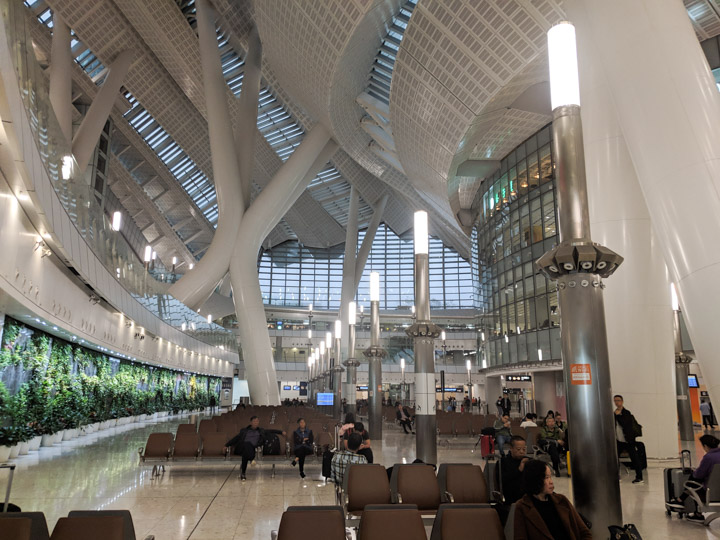
That’s the distance from Hong Kong to Beijing, and if you’re on a train that cruises at 306km/h, you can leave at 8:05AM and arrive one minute past five in the afternoon. The train has a number and a Wikipedia entry: G80 (check it out for some cool pix of the train). I suspect that not that many readers have taken this, so herewith words and pictures.
Hong Kong West Kowloon station is bright and new and huge.
[This is part of The Surface of China series.]
It’s faster than an airport but there are really a lot of stages to get through: HK exit, HK customs, security, PRC health, PRC customs, PRC immigration. They were all reasonably efficient and pleasant but damn it’s a lot of walking. Obvious foreigners are waved over to the “special services” PRC immigration where they speak English. As in most dictatorships, there’s plenty of assiduous filling-in of forms and triple-checking numbers and photos and signatures.
The train interior is, well, meh. Nothing terribly wrong with it but not as slick as either the Japanese shinkansen or a Euro-TGV/ICE. There are classes: Business, First, Second. We took the mid-range First; the price was reasonable and the seats were OK, with a bit of lean-back and plenty of electricity.
The food was awful, but it’s been a long time since I got good food on a train anywhere. I had to respect the staff, who pushed the tea-carts and refreshments back and forth for nine consecutive hours without exhibiting fatigue. None seemed to have a word of English.
If you want to travel, direct online ticket sales are difficult-at-best for foreigners. We followed leads around the Internet and eventually bought the tickets via China Highlights, who got them from the station and delivered them to our Hong Kong hotel before we got there.
Traveling at 300km is sort of dreamy. I don’t have a good way to host video myself, so here are 27 seconds on YouTube.
During the first couple of hours, the sky was that South Chinese dappled-grey while the terrain was green, folded, and wet.
Two thousand kilometers, but rarely out of sight of human habitation, and never away from infrastructure: Power lines, dikes, culverts, you name it.
As we worked our way north the land became flatter and dirtier and more industrial and more intensely under construction. This picture is unusual in that there are no visible cranes.
Any extended exposure to China — this theme will recur — leaves most Westerners overwhelmed by its most significant fact: its huge population. On this trip the train stopped at Shenzhen (pop 12.9M), Guanghzhou (14.9M), Changsha (a mere 7.4M), Wuhan (10.6M), Zhengzhou (10.1M), and Shijiazhuang (10.8M). Total: 66.7M human souls. You can claim you already knew about those places but I probably wouldn’t believe you.
It’s not subtle: as you coast from city to city, often the horizon hides behind a forest of high-rises.
In the picture above, it all looks kind of prosperous: The pretty-modern buildings in the background, the gas stations and boulevards in front. It’s not all like that; in the hilly green southern section you see really poor-ass rural scenes, but the surface prosperity monotonically increases as you move further north and toward Beijing.
Wherever you go in the world, you can usually tell a lot about a person by their address, and even more by visiting that address and looking at their residence. I’m sure you can in China too, only I can’t because I don’t know anything, and it was frustrating. There were low primitive places among the fields, little better than shacks, then two-story countryside clusters that offered a little room but no apparent luxury, then the ubiquitous apartment towers, low and high, shiny and faded. What does it all mean? Ask elsewhere.
I noticed that out away from the cities there was a lot of empty space on the roads; thought how much fun it might be to do a road trip in a fast car.
Obviously, China’s decades-long avalanche of investment and development hasn’t had flawless execution. There are many towers built but not finished, their windows unoccupied concrete rectangles, some finished partway up but no apparent work in progress. Bridges and causeways and berms and embankments too: infrastructural work paused and left to stand like huge pieces of brutalist sculpture.
But of course lots of construction is in active progress; this near Beijing.
Beijing West station, when you get there, is insanely crowded but reasonably efficient; the only thing you have to be careful of is the taxi touts who I’m told will rip you off. They’re somewhat handicapped in that a native Chinese speaker who hasn’t studied English really has trouble with our letter “x”, but they have hustle. Follow the signs to the nice modern taxi-stand and you won’t have to wait long. It’s a good idea to visit your hotel’s website before you go and find the place where they provide a map-with-directions you can print out and show the driver.
Then you’re into Beijing traffic, and may God have mercy on your soul.
Comment feed for ongoing:
From: David (Apr 10 2019, at 14:33)
re: driving around China, see the Grand Tour China episode from Amazon.
[link]
From: Dan (Apr 11 2019, at 06:54)
Hey, thanks for writing this. I loved the ending.
[link]